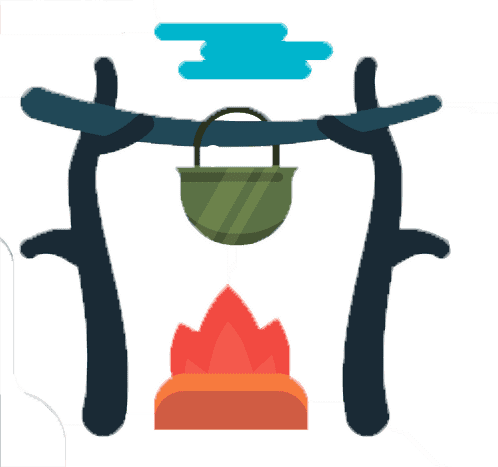
Mountaineering
BeginnerHiking
BeginnerRock Climbing
BeginnerIce Climbing
BeginnerBackcountry Skiing
BeginnerMountain Planet
12 years, Australia
10 Don’ts for Your 1st Outdoor Trek
Line “the roof is on fire” is good for the rock song, but will not bring any good in rock outdoors. Check 10 obvious novice’s mistakes for the first trekking in the wild.

1. Don’t Cook the Meals Inside the Tent
If you think that the stories about burning down the tent are the tales, that experienced trekkers tells to novices, then don’t.
 The modern bivvy equipment are made of all man-made materials and may burst into flames like a match. So if you don’t want to part with your new (or used, or let alone rented) gear, never put a stove inside the tent despite the fact how terrible the weather is.
The modern bivvy equipment are made of all man-made materials and may burst into flames like a match. So if you don’t want to part with your new (or used, or let alone rented) gear, never put a stove inside the tent despite the fact how terrible the weather is.
At the worst, use the bivvy tent; and if it’s raining like cats and dogs, your destiny is to stay hungry or switch to dry food. A lack of hot meals will bring no tragedy, and the perspective of losing the tent in a bad weather can. Not mention the possibility of serious burn injury.
2. Don’t Allow Your Sleeping Bag Get Soaked
 Brrr, what could be more disgusting when lying in the wet sleeping bag? In order to prevent this nuisance, keep the bag in dry sack or (in absence of this gear) just in plane plastic pack or standard bin bag. Also you may put all the sleeping properties inside (thermal underwear, spare socks, etc.).
Brrr, what could be more disgusting when lying in the wet sleeping bag? In order to prevent this nuisance, keep the bag in dry sack or (in absence of this gear) just in plane plastic pack or standard bin bag. Also you may put all the sleeping properties inside (thermal underwear, spare socks, etc.).
This precaution will come handy even if the fabric of you backpack marked as “waterproof”: forewarned, forearmed.
3. Don’t Wear Too Tight Boots
 One of the main rules for long trekking is: never wear true to size boots. What comes as natural for the city shoes, can turn a fatal mistake in the outdoors. Lifehack: when buying a pair of footgear, take the trekking socks with you, and try the boots in the evening or after the walking around.
One of the main rules for long trekking is: never wear true to size boots. What comes as natural for the city shoes, can turn a fatal mistake in the outdoors. Lifehack: when buying a pair of footgear, take the trekking socks with you, and try the boots in the evening or after the walking around.
And even weared off shoes can turn your foot sore and swell after the long days of walking. To preclude this mess, buy boots in a half or one size bigger (but certainly they shouldn’t be too loose). Feet’s “strategic” points can be lubricated beforehand, with special anti-blister stick (Compeed or any other footcare products).
4. Don’t Bring Too Many Clothes
 Outdoors is not a party, although one does not cancel the other. Anyway the reality is plain: you shouldn’t pack all your t-shirts and fleece along. For 10-days trek 2 short-sleeve t-shirts and 2 long-sleeves will be enough. Add on polar for the night stands and/or insulated/down vest. Don’t forget the thermals, pair of pants and shorts. Flip flops as the changing shoes will be the best choice.
Outdoors is not a party, although one does not cancel the other. Anyway the reality is plain: you shouldn’t pack all your t-shirts and fleece along. For 10-days trek 2 short-sleeve t-shirts and 2 long-sleeves will be enough. Add on polar for the night stands and/or insulated/down vest. Don’t forget the thermals, pair of pants and shorts. Flip flops as the changing shoes will be the best choice.
Lifehack: ask the attendant of your closest outdoor shop about the clothes with the sun-screen factor, it will be very convenient on summer trips.
5. Don’t Place the Tent on the Low Grounds
 Do you like to swim? Everybody likes to swim, but not inside your tent during the rain. Therefore, choose the place for your camp thoroughly. Look around and check the clearing: if it seems like former puddle, in case of even light rain you may wake up on waterbed (not bought in the store).
Do you like to swim? Everybody likes to swim, but not inside your tent during the rain. Therefore, choose the place for your camp thoroughly. Look around and check the clearing: if it seems like former puddle, in case of even light rain you may wake up on waterbed (not bought in the store).
If the weather is questionable, better dig up a little drain around the tent, when yet in heavy precipitation you will enjoy dryness while your less clairvoyant friends will be jump around the camp yelling out abuse. Well now you have a reason to tell: you had that coming!
During the thunderstorm you should not place the tent under high trees, but we believe that you know it already.
6. Don’t Feed Wild Animals
 If you don’t want to befriend with bear or any representatives of the wildlife, don’t forget to secure your food. The better way is to find an appropriate tree brunch (from 20 to 25 feet overhead), that extends far enough from the trunk. Place the supplies divided in the sacks up there.
If you don’t want to befriend with bear or any representatives of the wildlife, don’t forget to secure your food. The better way is to find an appropriate tree brunch (from 20 to 25 feet overhead), that extends far enough from the trunk. Place the supplies divided in the sacks up there.
And it is not about losing your stores only. If the free-roaming animals of any kind starts to find out that the humans are the easiest way to capture the food, it leads to the changing of beast’s feeding skills and accustoms to associate people with bait. Guess yourself the aftermath.
7. Don’t Drink Unboiled Water
 As a rule, the water in the underpopulated areas (which includes outdoors) is the way cleaner than in the cities. But for instance you may not know, how many cattle are grassed upstream the “clean” creek. Diarrhea is not an option on the vacations, so boil the water or use disinfectant agents as imperative. Either use the water filters.
As a rule, the water in the underpopulated areas (which includes outdoors) is the way cleaner than in the cities. But for instance you may not know, how many cattle are grassed upstream the “clean” creek. Diarrhea is not an option on the vacations, so boil the water or use disinfectant agents as imperative. Either use the water filters.
It will be handier if you mark all the drinking water sources on your route beforehand.
8. Don’t’ Underestimate the Weather
 Why in summer one should take the beanie to the outdoors? That’s why. The temperature in the mountains may change fast; and if you sunbathe in the morning, at night you can catch a cold as easy as one-two-three. This is definitely not an adventure one should experience far from civilization.
Why in summer one should take the beanie to the outdoors? That’s why. The temperature in the mountains may change fast; and if you sunbathe in the morning, at night you can catch a cold as easy as one-two-three. This is definitely not an adventure one should experience far from civilization.
Instead of the traditional polar you could use a “down sweater” – this modern outfit is extremely lightweight. Light gore-tex jacket will be perfect choice for the rain, and the poncho will keep dry not only you but a backpack also.
9. Don’t Neglect Navigation Skills
 Progress is a part of our life, the modern person does not imagine the being without different useful gadgets. But do not underestimate good old map & compass. The batteries in you trekking device may run out of charge, and power banks are not endless. So lay out your rout before going to the underpopulated areas and take some training to orient in the wilds.
Progress is a part of our life, the modern person does not imagine the being without different useful gadgets. But do not underestimate good old map & compass. The batteries in you trekking device may run out of charge, and power banks are not endless. So lay out your rout before going to the underpopulated areas and take some training to orient in the wilds.
Also please remember the sad wisdom of Aron Ralston (lost mountaineer, who’s story served as a plot for “127 hours” movie by Danny Boyle). Aron does not notify anyone about his trek, so nobody was worried of his disappearance. Schedule checkpoints and control time of your route passage; do not provide the rescuers with extra work.
10. Don’t Leave Any Garbage in the Wilds
 So, the garbage – last but not least item of your being in the wilderness. True travelers a long time ago start practice the principle: “Only footprints will remain after us”. Let’s share it worldwide!
So, the garbage – last but not least item of your being in the wilderness. True travelers a long time ago start practice the principle: “Only footprints will remain after us”. Let’s share it worldwide!
Here are some useful memo concerning your garbage behavior:
- Do not use bio degradable soap near the water supplies
- Take your garbage with you
- Please bury you poo in the ground
- Always remember about fire safety
- Do not feed the animals.
And the mountains and forests certainly say “Thank you” for your mature attitude.
***
Mountainplanet.com is a global geo-informational social network which wants to help mountain guides, clients and all outdoor enthusiasts to communicate and locate each other better.
Register on Mountainplanet.com as a guide, outdoor enthusiast or athlete, share your experience and emotions and let’s make the mountains safer and accessible together — for people who are looking for memorable outdoor experiences.





